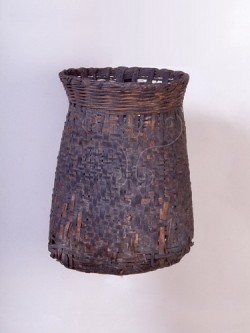
Introduction
Fish traps were considered essential items among Taiwan’s indigenous tribes that carried out fishing as part of their livelihood. These traps were placed along the coast or in a stream or river for small-scale fishing of fish, shrimp, crabs and shellfish. Such traps were tapered to hold in the catch and allow it to accumulate.
Shapes
Fish traps were woven from rattan. The body is in the form of a flattened bottle with a flared mouth, tapered neck and rectangular body. At the neck, a rope is attached for carrying and hanging when not in use.
Production methods
Long strips of rattan bark were used to weave the fish trap into a flattened bottle shape with a rectangular bottom using plaiting methods. The body of the fish trap was produced using twill weaving methods. For the construction of the neck, wicker weaving methods were used. In addition, a rope was tied at the neck for ease of carrying and hanging when not in use. Around the edge of the mouth, the ends of the rattan strips were inserted to complete the trap.
The fish trap was placed in a river or stream to collect small fish, shrimp, crabs, shellfish and frogs. The tapered end prevented escape. In addition, small openings were made along the body of the trap to allow water to flow through and keep the catch alive until the trap was removed from the water.
The international digital archives and e-learning communication project of the National Museum of Natural Science
National Museum of Natural Science
|













